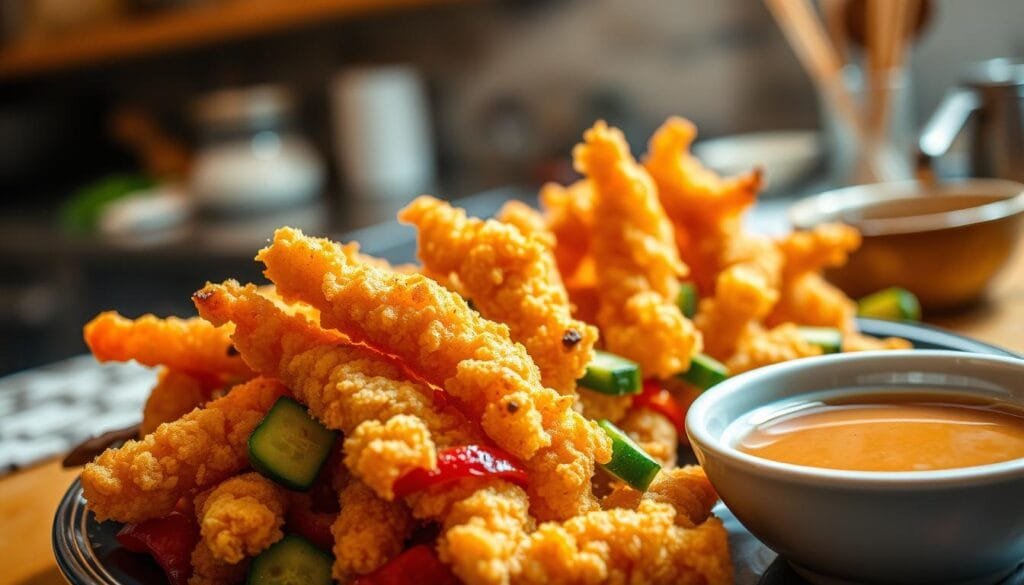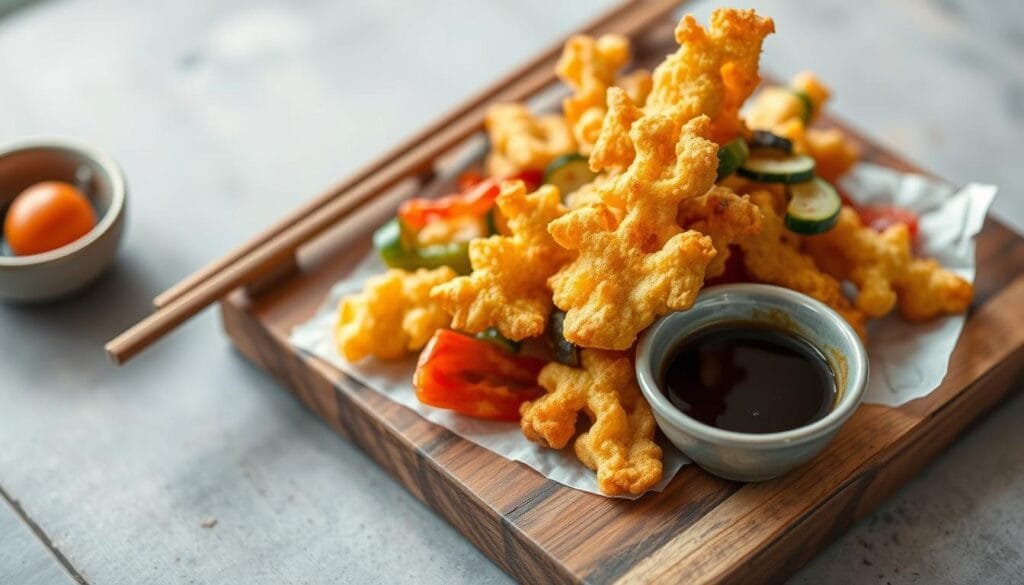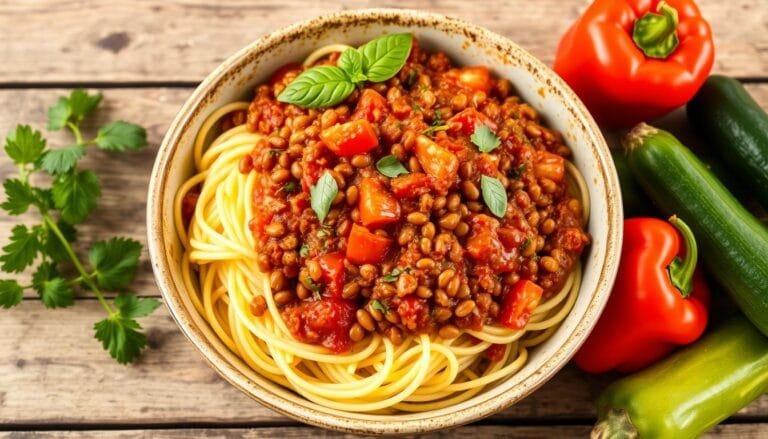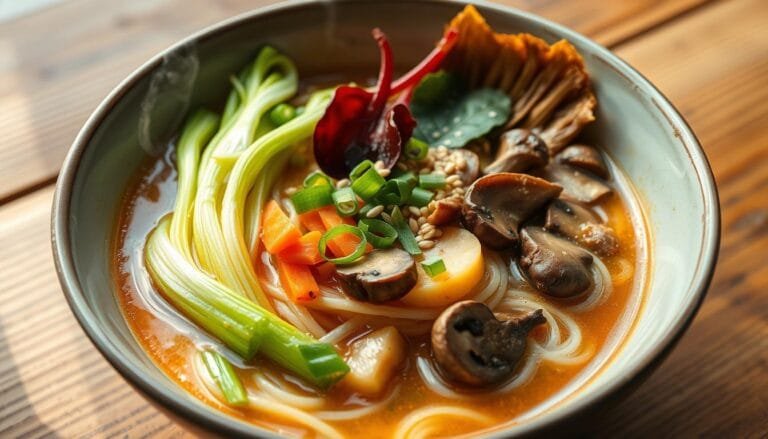I’ve always loved Japanese food, from sushi to yakitori. Recently, I found a vegan version of tempura. It’s crispy and delicious, perfect for anyone who cares about animals and the planet.
Vegan tempura uses a special batter that makes it light and airy. It cooks in just 20 minutes. This makes it a quick and tasty way to enjoy Japan’s flavors without harming animals.
As a vegan, I’m always searching for tasty, animal-friendly food. Vegan tempura is perfect because it’s good for everyone. It lets you enjoy Japan’s flavors without worrying about animal products.
Understanding Traditional Tempura and Its Vegan Evolution
The history of tempura started in the 16th century, brought to Japan from Portugal. Over time, it became a favorite dish known for its crispy and delicate taste. This dish is rooted in Japanese culinary traditions.
Origins of Tempura in Japanese Cuisine
Tempura’s roots are deep in Japanese culinary traditions. It was influenced by Portuguese deep-frying methods during the Edo period (1603-1868). Today, tempura is known for its unique batter and cooking style, blending flavors and textures perfectly.
The Rise of Plant-based Alternatives
Traditional tempura includes seafood and veggies, but vegan versions are now popular. Chefs and home cooks are making plant-based tempura with veggies like bell peppers and mushrooms. These vegan tempura dishes keep the original’s spirit while appealing to those who follow plant-based diets.
Cultural Significance in Modern Cooking
The history of tempura is a big part of Japanese food culture. Its popularity has grown as more people want plant-based options. By keeping the Japanese culinary traditions and adding plant-based ingredients, tempura is loved by many today.
Essential Ingredients for Plant-based Tempura
Making delicious vegan tempura starts with the right ingredients. The perfect batter comes from mixing all-purpose flour, cornstarch, rice flour, and baking powder. This mix gives us a light, airy texture, just like traditional tempura.
The batter recipe includes 1/2 cup of chilled sparkling water or cold beer. This adds a crisp, golden-brown coating that keeps the veggies’ natural flavors inside. You can use a wide range of veggies, like sweet potatoes, mushrooms, zucchini, bell peppers, broccoli, and eggplant. You can also try vegan alternatives like tofu or plant-based shrimp for something different.
For the best fry, use high-heat cooking oil like peanut or canola oil. Adding a pinch of salt, garlic powder, onion powder, or nutritional yeast to the batter can also enhance the flavor. With these ingredients, you’re ready to make a tasty vegan tempura.
- All-purpose flour
- Cornstarch
- Rice flour
- Baking powder
- Chilled sparkling water or cold beer
- Vegetables (sweet potato, mushroom, zucchini, bell pepper, broccoli, eggplant)
- Vegan alternatives (tofu, plant-based shrimp)
- High-heat cooking oil (peanut or canola)
- Optional seasonings (salt, garlic powder, onion powder, nutritional yeast)

“The secret to the perfect vegan tempura lies in the balance of ingredients, from the airy batter to the carefully selected vegetables.”
Remember these key ingredients to make delicious plant-based tempura. It’s a tasty take on the Japanese classic.
The Perfect Vegan Tempura Batter Recipe
Creating the perfect vegan tempura batter is key to making delicious, crispy, and light tempura. It’s all about finding the right mix of dry and wet ingredients. Also, mastering how to mix and control the temperature is important.
Key Components and Proportions
The base of a great vegan tempura batter is a 1:1 ratio of flour to liquid. You can use all-purpose flour, rice flour, and sparkling water or cold beer. The dry mix includes 1/3 cup of cornstarch, 1/4 cup of all-purpose flour, 2 tablespoons of rice flour, and 1 teaspoon of baking powder.
Mixing Techniques for Optimal Crispiness
- Slowly add 1/2 cup of ice-cold sparkling water or beer to the dry ingredients while gently stirring to create a smooth batter.
- Avoid overmixing the batter, as this can develop too much gluten and result in a dense, chewy texture instead of the desired light and crispy tempura.
- After mixing, chill the batter in the refrigerator for a few minutes before using to help maintain the optimal temperature for frying.
Temperature Control Tips
Keeping the oil at the right temperature is key for perfect crispy tempura. The ideal range is between 350-375°F (176-190°C). Use a reliable digital thermometer to monitor the oil temperature and adjust the heat source as needed to keep it within this optimal range.
By following these guidelines for the vegan tempura batter recipe, you’ll be well on your way to creating the most delectable and crispy plant-based tempura at home.
Best Vegetables for Tempura Frying
Creating tasty tempura vegetables is a fun adventure! You can use sweet potatoes, bell peppers, zucchini, and mushrooms. These veggies are great for plant-based frying because they stay firm and get crispy.
Try using seasonal veggies like asparagus and zucchini for a fresh taste. Mushrooms like shiitake, oyster, and enoki add special textures and flavors. Leafy greens like kale or collards make great crispy snacks. Even pickled veggies can add a tangy twist to your dishes.
- Sweet potatoes
- Bell peppers
- Zucchini
- Broccoli
- Cauliflower
- Asparagus
- Green beans
- Mushrooms (shiitake, oyster, enoki)
- Onion rings
- Eggplant
To get your tempura vegetables just right, keep the oil hot and use a light batter. With a bit of practice, you’ll make amazing vegan tempura dishes!

Mastering the Art of Plant-based Tempura
Making perfect plant-based tempura is an art that needs careful technique and detail. Every step, from oil temperature to coating, is key for that crispy texture and golden color. Let’s explore the main parts of mastering vegan tempura frying.
Oil Temperature Management
Keeping the oil at the right temperature is vital for tempura frying. The best range is 350-375°F (176-190°C). Use a deep-fry thermometer to check this. This temperature ensures a quick, even cook, making the tempura light and crispy.
Proper Coating Techniques
Dipping vegetables in batter is a careful move. Gently dip each piece, letting excess batter drip off before frying. This avoids greasy tempura. Fry in small batches to keep the oil temperature steady and cook evenly.
Timing and Color Indicators
The ideal vegan tempura is golden brown and crispy but not too dark. Fry for 1-2 minutes, turning the vegetables gently for even cooking. Watch the color closely, taking it out when it’s light golden. Drain on paper towels or a wire rack to get rid of excess oil.
“The key to perfect tempura frying lies in striking the right balance between temperature, technique, and timing. With a little practice, you’ll be crafting restaurant-worthy vegan tempura in no time.”
Creating Flavorful Vegan Dipping Sauces
When it comes to making plant-based vegan tempura better, the sauce is key. I’ve made a vegan version of traditional Japanese tentsuyu sauce. It’s rich in umami without any animal products.
To make the sauce, I use vegan dashi or vegetable broth as a base. I mix in soy sauce, mirin, a bit of salt, and ponzu sauce. Adding grated daikon radish gives it a pungent flavor. This sauce is savory, sweet, and perfect for tempura.
But there’s more to vegan tempura than just the sauce. I also try out other dipping sauces like sweet chili sauce or ginger soy sauce. Sometimes, I add wasabi, sesame oil, or citrus zest for extra flavor.
| Dipping Sauce | Key Ingredients | Flavor Profile |
|---|---|---|
| Vegan Tempura Sauce | Vegan dashi, soy sauce, mirin, ponzu, daikon | Savory, umami, slightly sweet |
| Sweet Chili Sauce | Chili sauce, rice vinegar, maple syrup, garlic | Sweet, spicy, tangy |
| Ginger Soy Sauce | Soy sauce, rice vinegar, grated ginger, sesame oil | Savory, gingery, slightly nutty |
These plant-based dips are great because you can change them up. Feel free to mix and match ingredients to find your favorite sauce for vegan tempura.
“The right dipping sauce can elevate a simple tempura dish into a culinary masterpiece.”
Common Mistakes to Avoid When Making Tempura
Making delicious vegan tempura is like an art. Even experienced cooks can run into problems. To make sure your tempura is always crispy and tasty, avoid these common mistakes.
Batter Consistency Issues
The batter is key in tempura. Don’t overmix it, or it will be tough. Mix the ingredients gently for a light batter. It should coat the veggies well without being too thick.
Temperature Control Problems
Keeping the oil at the right temperature is essential. If it’s too hot, the outside will burn before the inside is cooked. If it’s too cold, the tempura will soak up too much oil. Aim for a temperature of 170-180°C (340-360°F).
Ingredient Selection Errors
Not all veggies are good for tempura. Choose ones that fry well, like Japanese sweet potato, Brussels sprouts, and basil leaves. Stay away from wet items like cherry tomatoes. They can burst and make a mess. Dry the ingredients well before battering to avoid oil absorption.
By avoiding these mistakes, you’ll get better at making tempura. You’ll enjoy making crispy, vegan frying tips that taste great. Use these plant-based cooking techniques to make your tempura stand out.

Serving and Presentation Techniques
Making the perfect crispy plant-based tempura is just the start. How you present and serve it can make a big difference. When it comes to tempura plating, show off the colors and shapes of the veggies. Keep that vegan appetizers crispness in mind.
Begin by placing the fried tempura on a big platter or plate. This lets the colors and textures stand out. Mix sweet potato, rainbow carrots, snap peas, and shiso leaves for a stunning Japanese-inspired presentation. Serve it right away to keep it crispy, and offer small bowls of dipping sauces like soy maple.
Garnishes can really enhance the dish. Try adding sea salt, green tea salt, or shichimi togarashi (Japanese seven spice) for color and flavor. Fresh daikon radish or ginger on the side adds a refreshing touch.
To make it a full meal, serve with steamed rice or soba noodles. Use bamboo leaves or shiso leaves as decorations. Give out chopsticks or small forks for a more authentic experience. For appetizers, use individual portions to make them more appealing.

The way you present your plant-based tempura is just as key as the recipe. Focus on the details and create a beautiful display. This will turn this Japanese dish into a culinary wonder that will amaze your guests.
Health Benefits of Plant-based Tempura
As a health-conscious foodie, I’m excited to share the good stuff about vegan tempura. It’s not just tasty; it’s also packed with nutrients. It’s a win-win for my taste buds and my body.
Plant-based tempura uses oils like avocado oil for frying. These oils are healthier because they can be fried at a high temperature without burning. The light batter also helps veggies keep more of their vitamins and minerals, unlike heavy batters that soak up oil.
Tempura with different veggies is a goldmine of nutrition. Sweet potatoes, broccoli, and mushrooms are full of fiber, vitamins, and minerals. These nutrients are great for your health. Plus, cooking them can make these nutrients easier for your body to use.
Remember, tempura should be part of a balanced diet. But it’s a tasty and nutritious choice for your plant-based meals. Try air frying it for a crispy texture with fewer calories.
“Tempura’s light batter allows vegetables to retain more of their natural nutrients compared to heavy batters that can absorb more oil.”
So, when you’re in the mood for Japan’s flavors, go for plant-based tempura. It’s a delicious and healthy treat for your taste buds.
Storage and Reheating Guidelines
Making delicious plant-based tempura is an art. But it doesn’t stop when you’re done cooking. Storing and reheating your vegan tempura right is key to keeping it crispy and golden. Let’s look at the best ways to keep your leftover tempura tasty.
Proper Storage Methods
After frying, let your tempura cool completely on a wire rack. This step helps prevent it from getting soggy. Once it’s cool, put it in an airtight container in the fridge for up to 24 hours. Don’t freeze it, as freezing can change its texture and quality.
Reheating for Optimal Crispiness
When you’re ready to eat your leftover tempura, don’t use the microwave. It can make it soggy. Instead, use an oven or air fryer to reheat it. Heat it to 350°F (175°C) for 5-10 minutes to get it crispy again.
For the best taste, eat your vegan food storage right after cooking. If you’re making tempura ahead of time, keep the batter and veggies separate in the fridge. This keeps them fresh and crunchy when you’re ready to serve.
“Proper storage and reheating techniques are the keys to maintaining the crisp, golden perfection of your vegan tempura creations.”
Pairing Suggestions and Side Dishes
Enjoying vegan tempura opens up a world of tasty sides. Steamed rice is a classic choice to go with it. For extra warmth, try a comforting miso soup with your tempura.
Cold soba noodles with a dipping sauce are a great side. You might also like pickled ginger or a light daikon radish salad. Edamame, cucumber salad, or seaweed salad add a fresh touch.
For a bigger meal, vegan sushi rolls are a great choice. Finish your meal with a light drink or green tea. You can also mix things up with a quinoa salad or other international sides. The options are endless for a tasty vegan Japanese meal.







